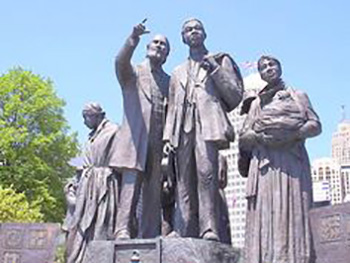 Click here to view or download a PDF.
Click here to view or download a PDF.
George DeBaptiste was born to free black parents in Fredericksburg, Virginia in 1816. As a young man, he apprenticed to a barber in Richmond, Virginia. Subsequently, he became a manservant to a wealthy southerner. Later he served as a personal valet to General William Henry Harrison. When Harrison became President of the United States, DeBaptiste was appointed as a White House steward. After Harrison’s death, DeBaptiste and his wife returned to their former home in Madison, Indiana.
Madison, Indiana overlooks the Ohio River and was a destination for runaway slaves from Kentucky. The Ohio River served as a fluid boundary between free Indiana and slaveholding Kentucky. DeBaptiste had briefly been employed on riverboats and may have used his knowledge to ferry slaves across the Ohio River to an Underground Railroad agent in Indiana. When riots against free blacks broke out in Indiana in 1845 and 1846, DeBaptiste moved his family to Detroit.
Detroit had an established free black community when DeBaptiste arrived in 1846. There was a black Baptist Church, a school for black children in the church building and several black-owned businesses. DeBaptiste engaged in successful commercial ventures: he purchased an interest in a barbershop, owned a catering business, and bought real estate. He rose in African American political circles and became known as an abolitionist and as the “superintendent” of the Underground Railroad.
The activities of the Underground Railroad in Detroit intensified in 1850 when the federal government passed the Fugitive Slave Law. The law permitted the apprehension and return of escaped slaves who had settled in free states. Detroit’s proximity to Canada, where blacks lived freely, made the city a uniquely important stop on the Underground Railroad. The Detroit River was a bustling port and an avenue of escape.
In 1850, DeBaptiste purchased the steamship, T. Whitney, and hired a white man to pilot it. The boat could be used as a commercial vessel and as a conveyance, secretly transporting ex-slaves to seek freedom in Canada. During this time, he served as a delegate to the Cleveland National Convention of Colored Citizens, and as an agent for the Freedman’s Aid Commission. He cofounded Detroit's Colored Vigilant Committee.
On March 12, 1859, DeBaptiste was one of the locally prominent abolitionists who met in Detroit with Frederick Douglas and John Brown to listen to Brown’s plans for armed rebellion at Harper’s Ferry, West Virginia.
When the Civil War began, DeBaptiste energetically worked to form the first Michigan Colored Regiment and was appointed the unit’s sutler. He helped provision the military during campaigns in the South. At war’s end, DeBaptiste returned to Detroit, sold the T. Whitney, and devoted his time to political causes; notably, the passing of the Fifteenth Amendment to the Constitution of the United States. DeBaptiste devoted considerable energy to abolish slavery in the United States and to guarantee the vote for all black males. He witnessed the achievement of both goals by the time of his death in Detroit in 1875. DeBaptiste is buried in Section C, Lot 24.
A statue in Hart Plaza, Detroit, is erected in his honor. It is pictured below. His homesite at East Larned and Beaubien streets is recognized with a Michigan Historical Marker and is listed in the National Park Service Network to Freedom.
 DeBaptiste is depicted pointing the way to Canada to this family of freedom seekers in this statue located in Hart Plaza, Detroit.
DeBaptiste is depicted pointing the way to Canada to this family of freedom seekers in this statue located in Hart Plaza, Detroit.

This material is based upon work assisted by a grant from the Association for the Study of African American Life and History (ASALH), funded by the Department of the Interior, National Park Service. Any opinions, findings, and conclusions or recommendations expressed in the material are those of the author(s) and do not necessarily reflect the views of ASALH or the Department of the Interior. Elmwood Cemetery’s Network to Freedom Application was completed by Carol Mull and Gabrielle Lucci. This biography was completed based upon the Application and records available through Elmwood Cemetery, Detroit Historical Society, Burton Historical Library, Military Records of the United States, Michigan Historical Center, and various information sources.
